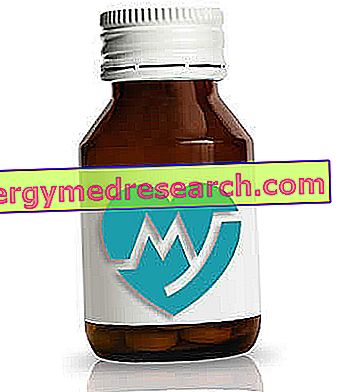What is Hemp Oil
Description of hemp oil
Hemp oil is obtained from the seeds of the homonymous plant (botanical name Cannabis sativa ), which contain it in percentages close to 30%.
Please note immediately that - using the subspecies (ssp.) Sativa - the risk of contamination of the oil by psychoactive cannabinoids is zero.
Marijuana or hashish oil
Hemp oil (in English "hemp oil") is NOT synonymous with marijuana oil or hashish (in English "hash oil"); the latter represents an oily substance, derived from Cannabis sativa ssp. Indica, which contains significant amounts of psychoactive cannabinoids.
The extraction of the fat component from the hemp seeds can take place with two different methods:
- Squeezing
- Solvent extraction.

Once refined, the hemp seed oil appears to have a softer color (almost transparent) and is better conserved; however, it loses much of its nutritional value.
Hemp seed nutrients
In hemp seeds, in addition to a good percentage of oil - which we have seen to be 30% - are found:
- 20-30% of insoluble fibers
- 20% of proteins with a medium biological value
- 10-15% carbohydrates.
What remains after extracting the oil is a powder called hemp flour.
Uses of hemp oil
Thanks to its chemical and physical characteristics (it is a drying oil, that is to say it also polymerizes in solid form) and nutritional (rich in "good fats"), hemp seed oil can be used for various purposes:
- Food - food seasoning
- Food supplement - has been shown to be useful in reducing eczema symptoms
- Fuel (bio-diesel)
- Natural non-polluting solvent - for paints and inks
- Impregnating agent for wood
- Hardener for plaster
- Lubricant
- Mixed in plastic materials - plasticizer
- Ingredient of detergents for personal hygiene such as soaps and shampoos.
Note : hemp oil has characteristics very similar to those of Tung oil.
Nutritional Properties
Lipid profile of hemp oil
Hemp oil contains 100% fats, consisting mainly of triglycerides and with less relevant fractions than other lipophilic molecules.
Cold-pressed oil has a lipid profile characterized as follows:
- 90% unsaturated fatty acids
- About 80% polyunsaturated
- About 10% monounsaturated
- 10% saturated fatty acids (especially palmitic and stearic acid).
The intake of linoleic acid (LA - polyunsaturated omega six essential) is equal to 55%, while that of alpha linolenic acid (ALA - essential omega three polyunsaturated) is equal to 22%.
Furthermore, discrete amounts (1-4%) of gamma linolenic acid (GLA - omega six polyunsaturated six are limited) and stearidonic acid (0.2% - non-essential omega 3 polyunsaturated acid) are also found.
The other lipophilic hemp oil molecules are:
- Phytosterols
- Tocopherols (vitamin E).
The content of trace cannabinoids, such as tetrahydrocannabinol (THC), is to be reported, although of little relevance; the concentrations of these psychoactive substances are so small as to make any "toxicity" phenomenon unlikely (a few liters per day would be needed).
Amount of alpha linolenic acid (ALA) - essential omega 3
Along with the oils extracted from other seeds (chia, perilla, flax, kiwi, cranberry, camellia, porcelain, sea buckthorn, walnut, canola, soya, etc.), hemp oil is one of the main dietary sources of alpha linolenic acid (ALA - progenitor of the omega three family).
| Amount of Alpha Linolenic Acid in the Oil Extracted from the Seeds of Certain Plants | |||
| Common name | Alternative Name | Linnea nomenclature | % ALA † |
| Chia | Salvia chia | Salvia hispanica | 64% |
| Kiwi | Chinese gooseberry | Actinidia chinensis | 62% |
| Perilla | Shiso | Perilla frutescens | 58% |
| Linen | / | Linum usitatissimum | 55% |
| Cranberry | / | Vaccinium vitis-idaea | 49% |
| Camellia | Camelina | Camelina sativa | 35-45% |
| Porcelain | Portulaca | Portulaca oleracea | 35% |
| Sea buckthorn | Sea berries | Hippophae rhamnoides L. | 32% |
| Hemp | Cannabis | Cannabis sativa | 20% |
| wot | English or Persian nuts | Juglans regia | 10.4% |
| Canola | Turnip from seed | Brassica napus | 10% |
| Soy | / | Glycine max | 8% |
| † average value | |||
Ratio omega 6 / omega 3 of hemp oil
Hemp seed oil is known for its optimal balance between omega six and omega three, present in a 3: 1 ratio respectively. On the contrary, as shown in the table below, in most of the oils consumed in Italy this ratio is clearly shifted towards the omega-six.
| Ratio Ω6 / Ω3 in some commonly used oils | |
| Linseed oil | 1: 4 |
| Rapeseed oil | 2: 1 |
| Hemp oil | 3: 1 |
| Soybean oil | 8: 1 |
| Olive oil | 9: 1 |
| Wheat germ oil | 10: 1 |
| Peanut oil | 62: 1 |
| Sunflower oil | 71: 1 |
In the past, based on certain experimental results (later revalued), some researchers hypothesized that the excessive intake of omega six fatty acids, compared to a reduced intake of omega three, could:
- Increase cardiovascular risk
- Facilitate the onset of other diseases with an inflammatory component, such as dermatitis, asthma, rheumatoid arthritis, etc.
The lack of these essential nutrients - which being such must necessarily be taken with the diet - has also been linked to the appearance of dysmenorrhea (see the article dedicated to menstrual pain).
Hemp oil in the diet
| Omega 6 / omega 3 ratio in human nutrition from the Paleolithic to the present | |
| Populations | ω-6 / ω-3 |
| Palaeolithic | 0.79 |
| Greece before 1960 | 1.00 / 2.00 |
| United States 2000 | 16, 74 |
| United Kingdom and northern Europe | 15 |
| Japan | 4 |
| Italy | 13 |
Like other oils, being composed exclusively of lipids, each gram (g) of hemp oil supplies the body with 9 kilocalories (kcal).
Approximately one tablespoon of hemp seed oil (about 10 ml) contains 1.7 grams of omega three, covering the entire needs of the adult.
Especially for the elderly and for weakened people, it is advisable not to substitute hemp oil for regular consumption of fish (at least two or three weekly portions), as we do not find significant amounts of eicosapentaenoic acid (EPA) in hemp oil ) and docosahexaenoic acid (DHA).
In fact, as much as human metabolism is able to derive EPA and DHA starting from ALA, this function is not necessarily sufficient to cover specific needs.
Kitchen
How to use hemp oil?
Hemp oil should preferably be consumed raw and, due to its low smoke point, should not be used in fries.
By virtue of its organoleptic and gustatory characteristics (pleasantness and delicacy), hemp oil lends itself to seasoning especially vegetables (for example salads) and bread (instead of extra virgin olive oil).
Preservation of hemp oil
Despite being less stable than the extra virgin olive oil, the richness of tocopherols (vitamin E) and other antioxidants (polyphenols, phytosterols, chlorophyll etc.) partly counteracts the high susceptibility to rancidity due to the richness of polyunsaturated fatty acids.
To fully enjoy the nutritional value of hemp oil and prevent oxidation and rancidity, it is very important to choose the products extracted by cold pressing and stored in dark glass bottles, well closed and kept away from light sources and heat. After opening, hemp seed oil should be stored and stored in the refrigerator.



